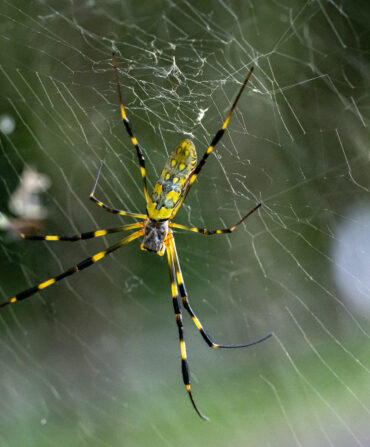I switched my phone to airplane mode, and the Okefenokee swallowed me up.
Just two days before I arrived at the swampy Georgia-Florida borderlands, I awoke at 4:00 a.m. to catch a flight from New York to Chicago to attend year-end company meetings, drank too many negronis at a holiday party, dragged myself to the airport to hurl my body through space to Atlanta and then Jacksonville, drove north for a twelve-person family dinner, slept in my childhood bed, attended a four-year-old’s Christmas pageant, and finally drove two hours south, largely in darkness, to the Stephen C. Foster State Park, Georgia’s southernmost gateway to the Okefenokee National Wildlife Refuge.

I had accepted an invitation for a three-night canoe trip with promises that the swamp’s mosquito swarms had quieted for the winter; alligators, those primordial beasts, would be subdued in the cold; and I’d eat well. The restaurant industry nonprofit Giving Kitchen was hosting the outing, and two Atlanta chefs had hauled down coolers full of tamales, taco and jambalaya fixings, steaks, and Brunswick stew for the crew.
I hadn’t visited the Okefenokee in close to three decades, not since taking grade-school trips to Okefenokee Swamp Park in Waycross, where I thrilled at boating next to ten-foot gators. But as an urban, nature-starved adult midway through her holiday sprint, paddling the swamp pummeled me with awe. I wondered at towering cypress trees reflected in the jet-black water. I heard the wing flap of anhingas flying overhead and the Rice Krispies–esque snap-crackle-pop of dried grass rustling in the breeze. I weaved through waterways just a few feet wide, dense with vegetation, and out into sundrenched lakes—an ecosystem now under threat, thanks to an impending mining proposal.
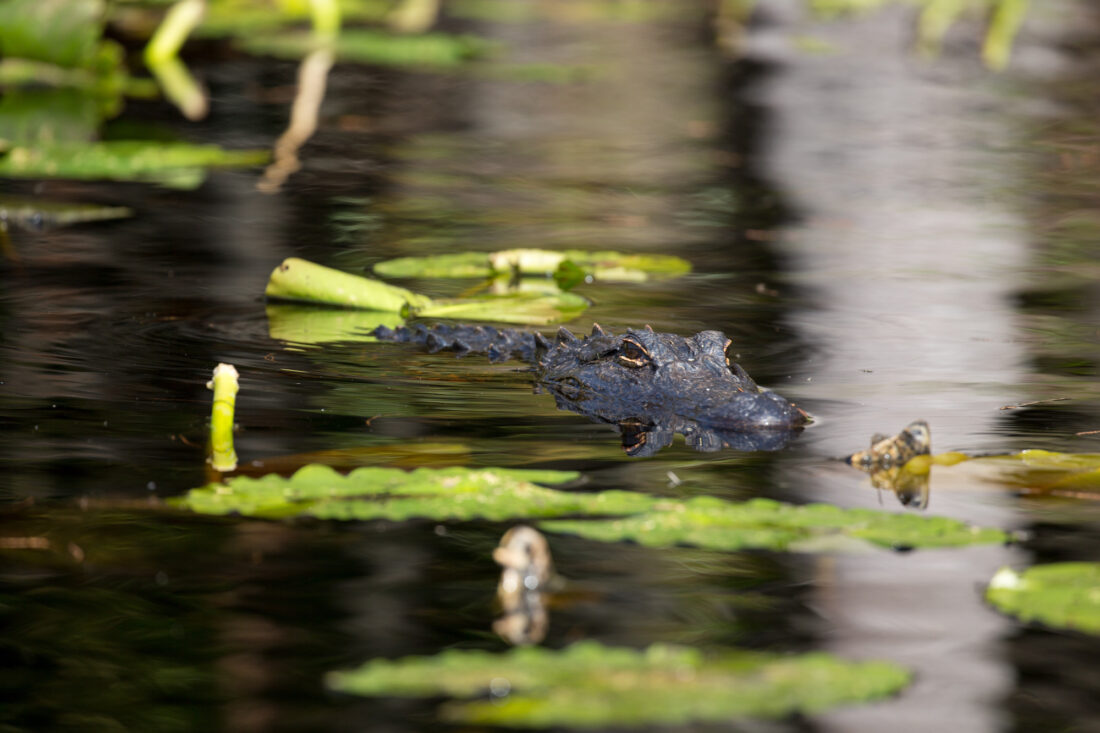
Antwon Nixon grew up five miles from the Okefenokee. He too visited on field trips and didn’t venture back into the swamp until two years ago. He didn’t even know he could access the refuge from his hometown. “The Okefenokee was never highly promoted,” says Nixon, now a pastor, community leader, and electrician in nearby Folkston, Georgia. “No one was talking about it.” Then in 2021, while attending a Juneteenth celebration, he happened across a sign warning of the possible mining operation on the swamp’s edge. Twin Pines, an Alabama company, was seeking approval to mine titanium dioxide on Trail Ridge, a natural swamp boundary, and the outfit touted the economic development and jobs it would bring to Charlton County. “Folkston is a prime place to bring promises and great hopes,” Nixon says. “The easiest thing to do is to dangle the fruit.”
Twin Pines has also promised that their work wouldn’t compromise the wildlife refuge, making its case and official position clear on its site: “Mining activities will not impact the Okefenokee Swamp.” However, scientists, conservationists, and devoted naturalists have since argued that mining Trail Ridge would have devastating ecological consequences. For the last few years, under the banner of the Okefenokee Protection Alliance, nearly fifty conservation organizations have built a movement to stop Twin Pines and permanently protect the swamp.
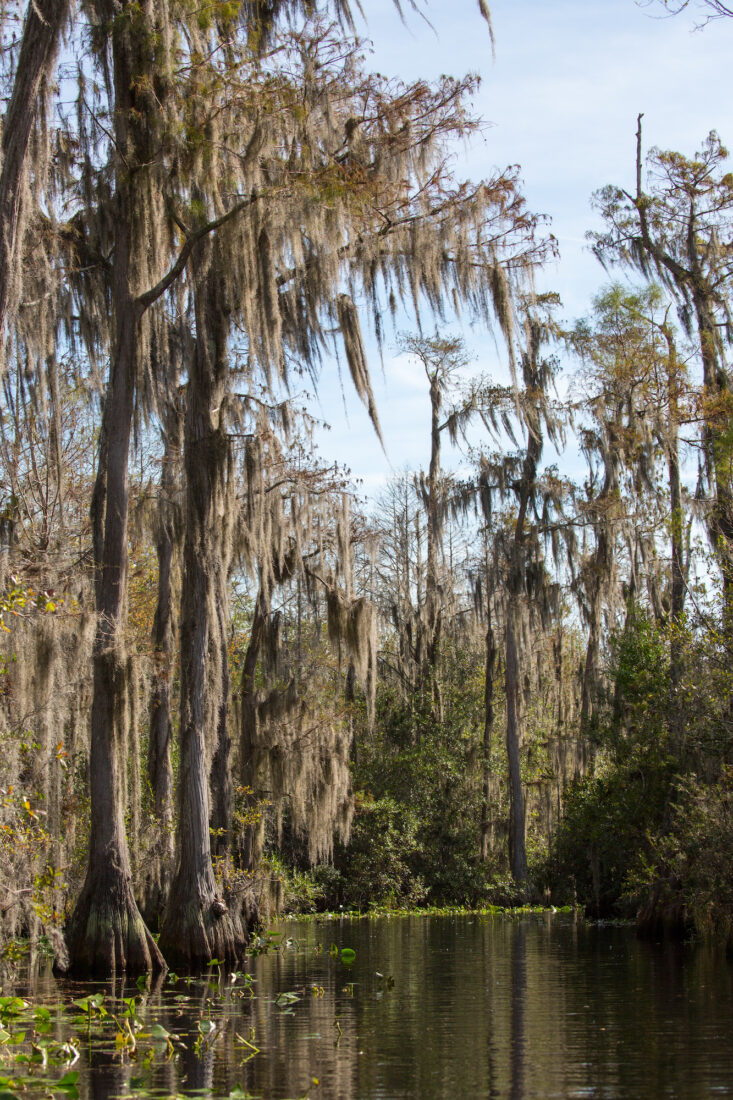
Despite opposition, including from U.S. Secretary of the Interior Debra Haaland, the Twin Pines proposal continues to move through the bureaucratic process. Since 2019, it has bounced between federal and state jurisdictions, and it’s now up to Georgia’s Environmental Protection Division to approve or deny.
In the meantime, the Georgia EPD is accepting public comments on the mining plan through March 20, a chance for citizens to make their voices heard, and Republican representative Darlene Taylor of Thomasville has introduced Georgia House Bill 71, the Okefenokee Protection Act, this legislative session with wide bipartisan support. If passed, the law would block future mining permits on the sections of Trail Ridge that border the swamp. “It’s a sweet spot in time for the public to get involved,” says Brian Foster, the communications director of the Georgia Conservancy.
Why the Okefenokee Ecosystem Matters
At 438,000 acres, the Okefenokee is the largest blackwater swamp in North America, its waters dyed like tea by slowly decomposing vegetation that, for the last five to seven millennia, has formed into a layer of peat on the swamp floor. This process of rotting happens slowly, thanks to the water’s low oxygen levels and high acidity.
Methane, a byproduct of this decomposition, forms under the peat and bubbles up. Not infrequently, the pressure of this swamp gas becomes so powerful that it blasts peat to the surface of the water. From there, seeds germinate on the fertile substrate. Small plants and then shrubs and trees grow up from it, and, in time, form islands. The name Okefenokee comes from this life and death cycle. The Miccosukee-Seminole word okifanô:ki means bubbling water or trembling earth.
Within this ecosystem lives incredible biodiversity: fifty species of reptiles (not just the almighty alligator), sixty species of amphibians, forty species of mammals (a young brown bear snooped around our campsite in December), six hundred plant species (three of which are carnivorous pitcher plants), and thirty-four kinds of fish. Two hundred bird species have also been spotted in the swamp.
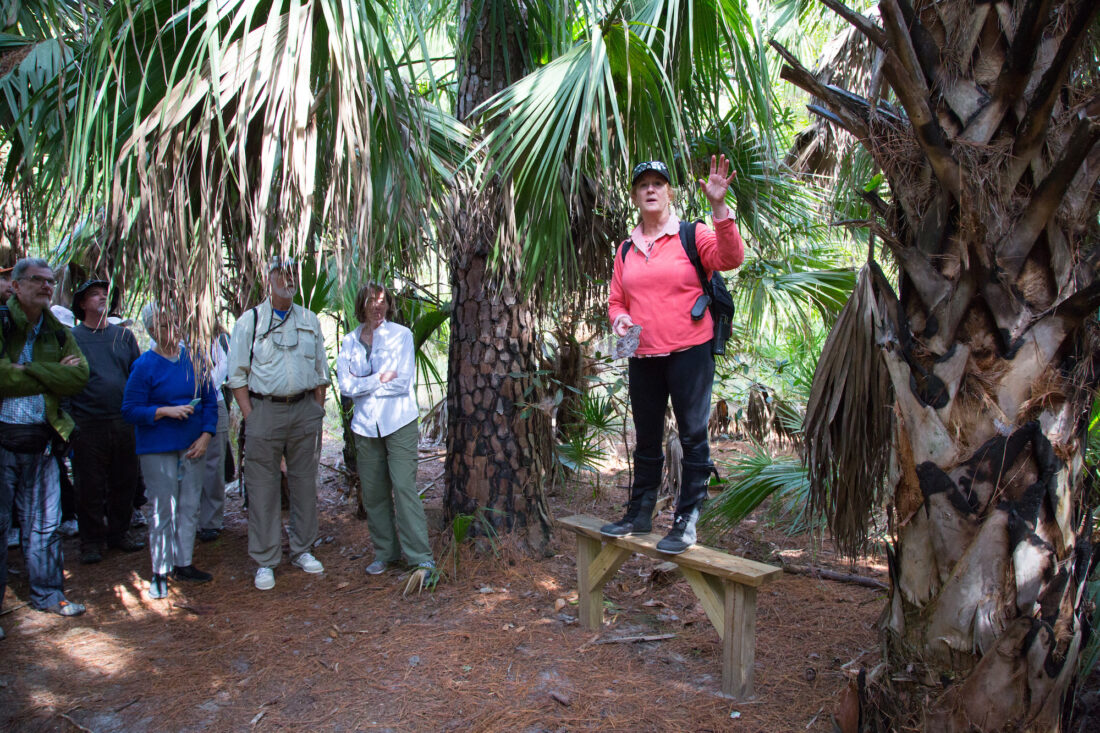
But the importance of the species and landscape there goes beyond the tangible, as I learned from Cathy Sakas—a naturalist, writer, and swamp goddess who guided my December trip. Sakas has taken more than 350 excursions to the Okefenokee since the 1970s, and her work there now centers on helping folks like me connect with nature (she also does a dead-on impression of the barred owl, whose mating calls punctuate the night there). That feeling I got, when I entered the swamp and breathed a little deeper and relaxed my shoulders? Sakas calls it swamp bathing. “You’re in this incredible wilderness area,” she says, “and it’s magical because of the energy you receive.”
Riches in the Swamp
Right before sunset on my first night in the swamp, our group paddled up to Mixons Hammock to set up camp, and Sakas pointed out wooden pilings that once supported a railroad. From 1908 to 1927, the Hebard Company logged 431 million board feet of virgin timber, mostly cypress, out of the swamp.
Once it became unprofitable for them to extract more timber, Hebard sold the land to the federal government, which under Franklin Delano Roosevelt established the Okefenokee National Wildlife Refuge in 1937. Its mission: to “protect and enhance wildlife and its habitat, ensure integrity of the ecological system, and embrace the grandeur, mystery, and cultural heritage that lead to an enrichment of the human spirit.” Additionally, the swamp earned its status as a National Wilderness Area in 1974.
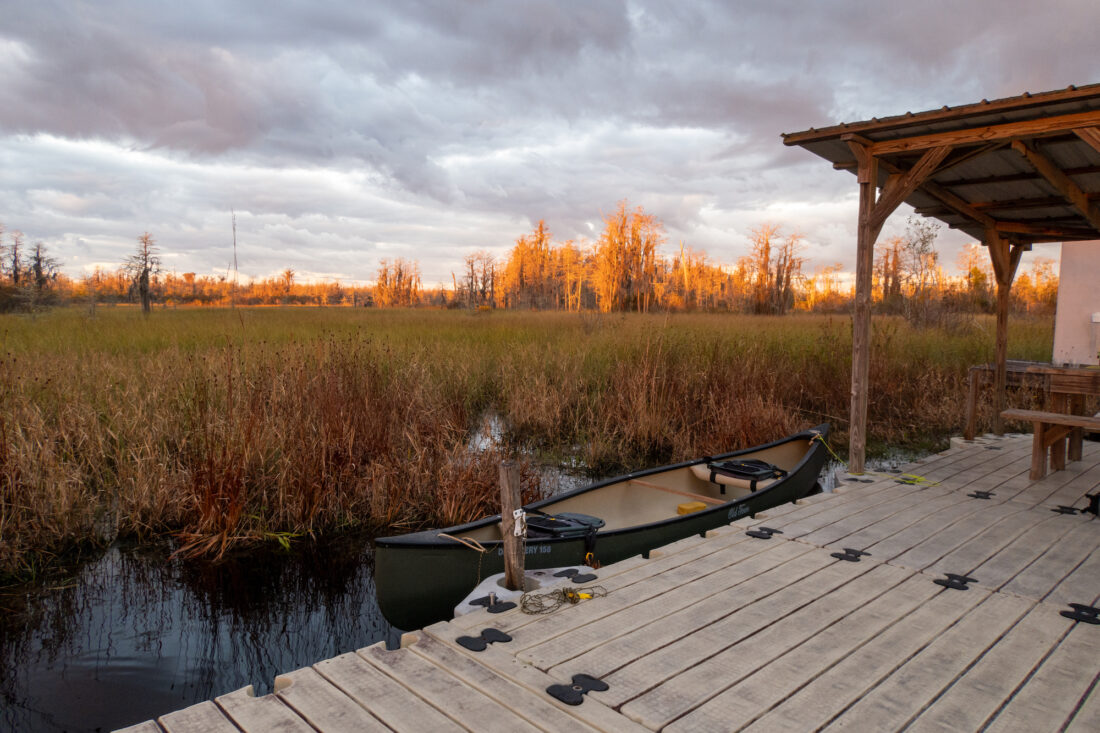
That designation provides the greatest protection land can have, the Georgia Conservancy’s Foster says, and, in the nineties, conservationists were able to scuttle a proposed DuPont mine on Trail Ridge. Decades later, Twin Pines feels like déjà vu. “The Okefenokee still can be destroyed from outside its boundaries,” Foster explains. “There’s only so much the U.S. Fish and Wildlife Service can do. Oftentimes, they can’t really affect what’s going on ten feet outside the boundary. How do we protect these iconic locations from outside forces?”
But what is it, exactly, that the mining companies want? As the ocean that covered South Georgia gradually receded after the Ice Age, a series of barrier islands formed near what’s now the Okefenokee. The coastline eventually descended a good fifty miles further east, and those islands became sandy ridges, the largest of which is Trail Ridge.
Today, Trail Ridge forms an earthen dam on the swamp’s eastern border. It also contains a payload of titanium dioxide, an abundant mineral mined on every continent except Antarctica. Twin Pines argues that titanium dioxide is critical to national security, as it’s used in the production of aircraft fuselage and engine parts. But globally, 93 percent of titanium dioxide is used as a bright-white pigment. Your house paint contains titanium oxide. You ingest it via bottled ranch dressing, marshmallows, and ice cream. You slather it onto your face with cosmetics and sunscreen and brush your teeth with titanium dioxide–enhanced toothpaste. Are we selling out the swamp, conservationists ask, for white gallery walls and dairy creamer?
What’s at Stake
For Sakas, one of the more magical parts of the swamp is the night sky. In 2016, the Stephen C. Foster State Park was named a “Gold-tier” Dark Sky Park by the International Dark-Sky Association. On my visit, a full moon lit our camp, but most nights the sky is freckled with innumerous stars and planets—an experience the bright lights of a 24/7 mining operation would diminish.
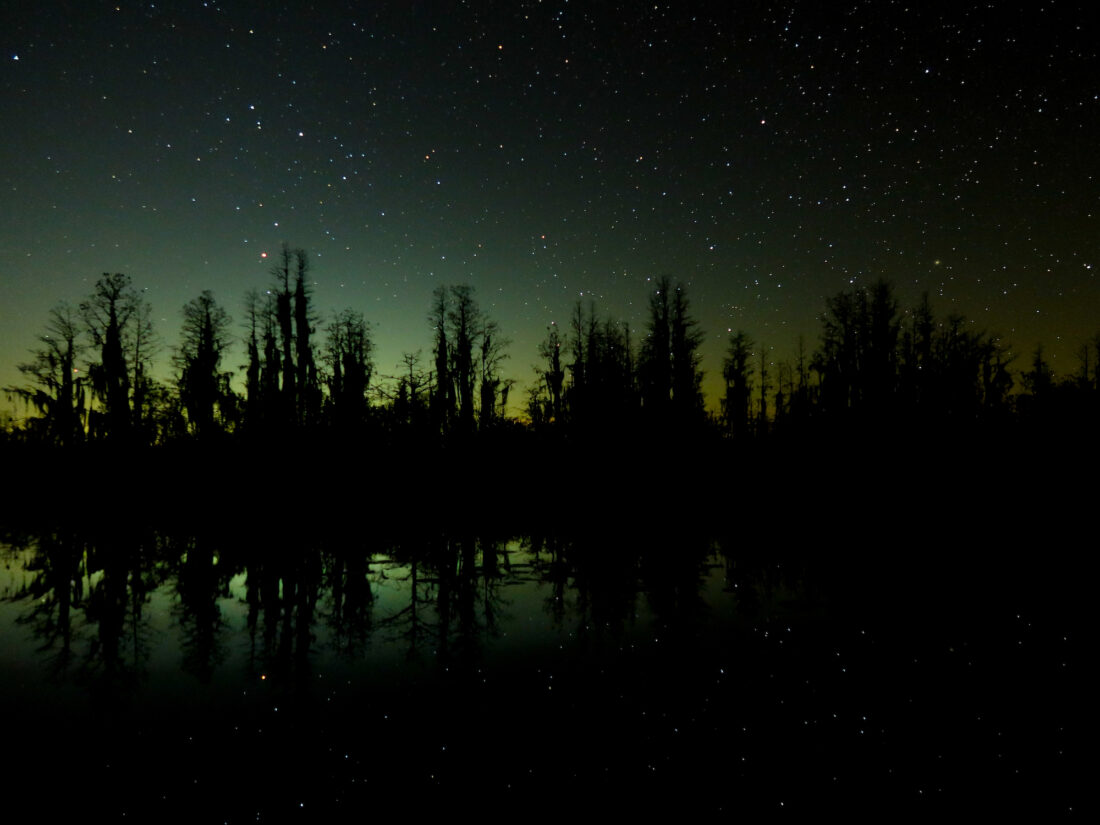
Then there’s the constant din of machinery that Sakas fears would interrupt frog choruses, bird calls, and alligator bellows. “You really feel a bellow rather than hearing it,” Sakas says. “We feel it in our sternum, and to not be able to hear that would be horrible.”
Noise and light pollution, obvious as they would be to visitors, are reversible. The potential impact to the swamp’s ecosystem would not be.
The Okefenokee, on average, is less than two feet deep (making it rather easy for novice paddlers like me to get hung on trees and stumps). The swamp’s water levels fluctuate throughout the year, and it loses more than 80 percent of its water to evaporation. The rest forms the headwaters of the Saint Marys and Suwannee Rivers that flow into the Atlantic Ocean and Gulf of Mexico, respectively. Some 75 percent of the swamp’s water comes from rainfall and the remaining from small streams and shallow aquifers (aka groundwater). And that’s the trouble.
The Trail Ridge mining pits would destroy ancient, complex geology and continually fill with groundwater. Twin Pines estimates that it will need to pump 1.128 million gallons a day out of the mine. “Half of the water pumped from the mining pit will come from groundwater that would otherwise flow into the Okefenokee Swamp,” says a study by C. Rhett Jackson, the John Porter Stevens distinguished professor of water resources at the University of Georgia. “This loss will be most noticeable during drought conditions, as it is this [groundwater] seepage that helps sustain the swamp during droughts.”
Mining, Jackson writes, would “triple the frequency of severe drought conditions.” Conservationists warn that lower water levels will destroy swamp ecology and threaten wildlife; diminish flow into the Saint Marys River, a breeding ground for the endangered Atlantic sturgeon; and increase the frequency and intensity of wildfires.
Another Side to the Swamp Economy
The environmental impacts of mining, conservationists argue, would also dampen tourism. The Okefenokee attracts 650,000 visitors a year and supports more than seven hundred jobs. Twin Pines says mining Trail Ridge will bring four hundred jobs to the region, but there’s no guarantee they would go to Charlton Country residents. Foster hypothesizes that “a lot of those jobs will most likely be filled by folks who have experience in the mining industry and have worked for Twin Pines operations in Florida or Alabama.”
Since taking over as the executive director of Okefenokee Swamp Park in 2021, Kim Bednarek has worked to develop an alternative economic narrative for the region. “A natural resources economy comes with the preservation of an incredible natural asset and how good that can be for a community,” she explains, “because investment does follow.”
At the center of her plans: helping the Okefenokee National Wildlife Refuge achieve status as a UNESCO World Heritage Site—typically a boon for tourism. The U.S. Department of the Interior can nominate just one site per year, and the swamp has been shortlisted since 1982. Georgia congressman Buddy Carter and Georgia senator Jon Ossoff, in particular, have begun lobbying for the Okefenokee, which by all accounts has boosted its position in the queue.

For Bednarek, it’s a matter of when, not if, and she’s working to ready the region with best-in-class educational facilities, restaurants, and lodging. Twin Pines, though an existential threat at this point, has also bolstered the swamp’s case. “There’s a crisis moment in the Okefenokee,” she says, “and it’s rallying a huge amount of attention and support. This is the opportunity, and we want the community to benefit.”
Nixon, the pastor and community leader, says Charlton County doesn’t have the infrastructure to fight Twin Pines alone, however, which is why he’s offered himself as a liaison between the county of nearly 13,000 and the rest of the world. “The swamp is ill valued,” he says. “If it was seen along the likes of the Grand Canyon or Yellowstone, we would not be having this issue. Ultimately, enough of us have to stand up.”
Enough of us have to visit the Okefenokee, too—drive the pine-lined, two-laned roads of South Georgia; turn off our screens; swamp bathe; in my case, buy a pup tent and less-than-attractive quick-dry pants; and definitely ignore the alligator and snake fearmongers.
Recently, Nixon went on his first overnight trip to the swamp. Along with ten other families—all first-time campers—he paddled the Okefenokee and Saint Marys, overcoming his own misgivings and fears to deepen his connection with the swamp. “It’s hard to advocate for things you don’t have experience with or care about,” Nixon says. “What you love, you speak up for.”



